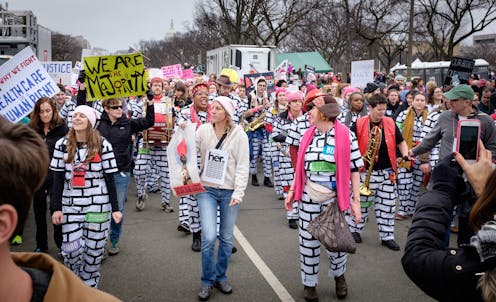Explainer: what does 'intersectionality' mean?
- Written by Carolyn D'Cruz, Senior Lecturer, Gender Sexuality and Diversity Studies, La Trobe University

“Intersectionality” – a word most commonly used in relation to feminism – can be hard to define and easy to abuse. Still, it remains essential for analysing and changing patterns of inequality and injustice.
Put simply, intersectionality shows how a feminism that focuses on women – without also addressing the fact that women come from different classes, and are marked by differences in ethnicity, sexuality, ability and more – favours the needs of those who are white, middle-class, heterosexual and able bodied.
Acknowledging that women are affected by other forms of marginalisation has sparked much debate within feminism. For instance there was intense discussion of intersectionality during the 2017 Women’s March in Washington DC. (One report had the headline “Women’s March Morphs Into Intersectional Torture Chamber”.)
Some feminists felt that emphasising differences between women detracted from common struggles. They did not like acknowledging that some women might be more privileged than others.
However this position elides the fact that non-white women experience discrimination on the basis of both gender and race. As Ruby Hamad and Celeste Little wrote in 2017, “mainstream feminism still cannot comprehend that racism and sexism are not experienced separately but simultaneously”.
The giddiness surrounding Hillary Clinton as almost First Female President™ and the silliness over Wonder Woman as First Female Superhero™ both fostered an atmosphere of hostility to any women who had the audacity not to feel “represented” by either.
Read more: Feminism has failed and needs a radical rethink
Where did the term come from?
The coining of the term is attributed to Kimberleé Crenshaw, a legal theorist of race and feminism. In 1989, Crenshaw wrote a legal paper titled, “Demarginalising the Intersection of Race and Sex: A Black Feminist Critique of Antidiscrimination Doctrine, Feminist Theory and Anti-Racist Politics”.
Crenshaw was analysing an anti-discrimination law case involving black women, who in 1976 had tried to sue General Motors for segregating their workforce along the lines of gender and race. At the time, black women could not get secretarial jobs, which went to white women. Jobs on the factory floor went to black men.
The law in the US dealt with racial discrimination and sex discrimination separately. This meant US courts could not deal with discrimination claims involving gender and race combined. Crenshaw put forward an analysis that focused on the intersection of gender and race in this case. To express this, she used the term “intersectionality”.
Crenshaw has charted the way feminist practices can neglect race issues and anti-racist struggles can reinforce sexism when dealing with issues such as domestic violence, rape and obscenity law.
When feminism refuses to put race into the frame of its analysis and activism, it can end up further excluding voices of women who have been colonised.
Read more: Why racism is so hard to define and even harder to understand
In the same year that Crenshaw coined “intersectionality”, Indigenous women in Australia, led by Jackie Huggins objected to white feminist anthropologist Diane Bell’s article, informed by Topsy Napurrula Nelson, Speaking about Rape is Everybody’s Business, published in an international feminist journal.
It was felt that Bell’s lack of an intersectional analysis reinforced racist ways of speaking about sexual violence. The issue was not whether everybody has the right to speak about rape, but how white feminists like Bell can drown out the voices of Indigenous women speaking for themselves.
‘Oppression Olympics?’
While Crenshaw’s term mostly focused on the intersection between race and gender, more recent uses of “intersectionality” have extended to include sexuality, gender diversity and disability.
A problem here is that the list of subordinated identities can become potentially endless, leading to a game of what Australian editor and writer Adolfo Aranjuez, among others, calls “Oppression Olympics”.
Aranjuez sums up the problem well when he says,
as a young, brown, queer, effeminate migrant with mental illness … I’m a minority on six levels, trumping a middle-aged, straight white man.
We are doing ourselves a political disservice if we rely on labels alone to arbitrate debates, he argues. “What this is about is preferring solidarity over separatism … Shutting someone down is a fleeting win; rectifying inequality in the long term is more than a game”.
Another unfortunate interpretation of intersectional analysis is the way many corporate and or government diversity and inclusion policies adopt the “add and stir” approach for each identity. Adding marginalised people to the table can be tokenistic without also addressing the structures of power that produce inequality in the first place.
Still, intersectionality is an important term. It helps us understand that the differences within an identity category, such as women, can be as significant as the differences that second wave feminists emphasised between women and men.
Authors: Carolyn D'Cruz, Senior Lecturer, Gender Sexuality and Diversity Studies, La Trobe University
Read more http://theconversation.com/explainer-what-does-intersectionality-mean-104937





